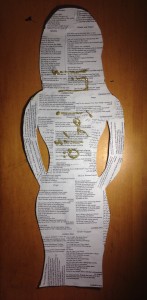“I am a Woman” – Collage Inspired by “We Sinful Women”
ø
EXPLANATION:
For this piece, I created a collage of the Urdu feminist poetry from “We Sinful Women” in the shape of a woman’s body, overlaid with “I am a woman” written in Arabic in glitter. I found these poems to be powerful in their complex, nuanced depictions of feminine identity and what it means to be a woman. The question of identity so often centers around a woman’s body and physical appearance in the deeply patriarchal societies of South Asia, so I thought it would be interesting to place the poems within the outline of a woman’s body to explore how the poetry grapples with the relationship between the body and feminine identity.
I tried to strategically place the poems (or fragments of poems) close to the part of the body they discussed or related to: Surah-e-Yaaseen by the woman’s feet talking her fear as “with hurriedly advancing footsteps, I am a lone woman”; She is a Woman Impure, placed over the woman’s abdomen, describes a woman as “imprisoned by her flowing blood”; a portion of Come, Give Me Your Hand, pasted by the women’s navel, reveals the beauty of physical identity through pregnancy and “the beating of your child’s heart on that side of the navel”; Image, glued over the woman’s heart, reveals the hidden identity “deep in the recesses of my heart”; Chadur and Diwari, placed over what would be the veiled portion of a woman’s head, passionately denounces veiling; and Akleema, pasted on the woman’s head, challenges the sexualizing of feminine identity, reminding men that above a woman’s “long thighs” and “high breasts,” “Akleema has a head.”
The poems have different takes on the relationship of the body to feminine identity – some viewing the body as a prison, some denouncing sexual objectification and double standards, some embracing the body as integral to womanhood, and others completely ignoring the body in favor of the mind. The variation in the poems highlight a common truth about feminine identity: women’s identities are complex and multi-faceted (despite the patriarchy’s efforts to portray them as two-dimensional), composed of many parts that complement and conflict with each other in equal measure. Taken together, the poems (and the facets of feminine identity they represent) form the shape of one complete woman.


